University Operations Management Assignment Solution Analysis
VerifiedAdded on 2022/11/14
|8
|1930
|397
Homework Assignment
AI Summary
This document presents a comprehensive solution to an Operations Management assignment, addressing key aspects of operations strategy, manufacturing, and service industries. The solution analyzes the operational challenges faced by a furniture manufacturing company, including production planning, cost control, and the impact of retail orders. It explores modern methods for improved operations management, emphasizing the role of the operations manager in achieving competitive priorities. The assignment also delves into various production techniques, such as make-to-order, mass production, and mass customization, and provides insights into cost reduction strategies, including labor cost reduction, material cost reduction, and the utilization of lean manufacturing. The document also contains a brief overview of the assignment brief, providing context for the provided solution. This assignment is a valuable resource for students seeking to understand and excel in operations management.
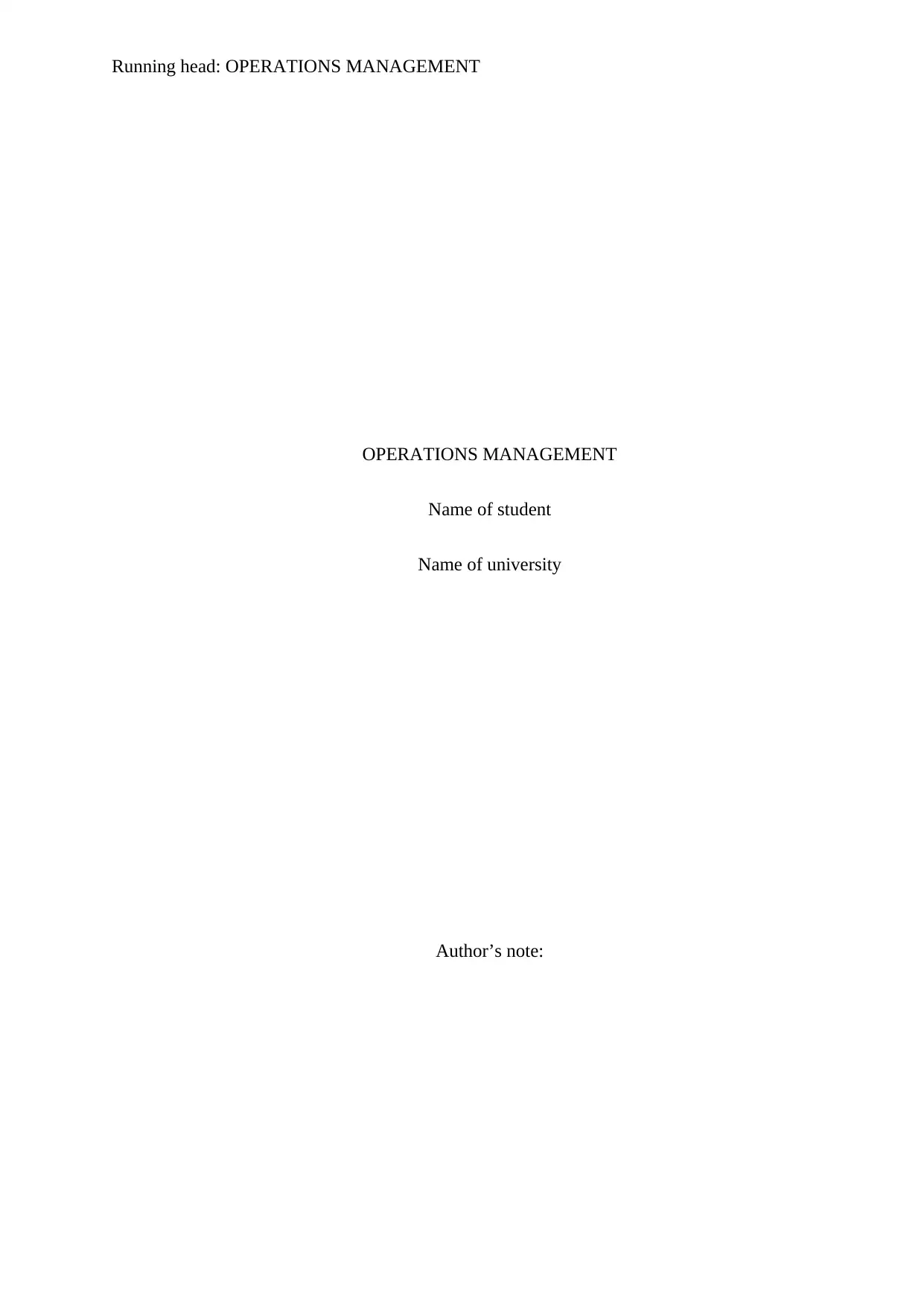
Running head: OPERATIONS MANAGEMENT
OPERATIONS MANAGEMENT
Name of student
Name of university
Author’s note:
OPERATIONS MANAGEMENT
Name of student
Name of university
Author’s note:
Paraphrase This Document
Need a fresh take? Get an instant paraphrase of this document with our AI Paraphraser

1
OPERATIONS MANAGEMENT
Answer of question 1:
Presently, the company of Chad operates the sole manufacturing centre in Sandusky,
where the manufacturing of both the customs as well as the standard furniture is done. In the
last limited months, the sales of the regular line steadily significantly improved, that leads to
increasingly consistent scheduling of the line. As Chad analyses the development of the
Creative Concepts, the owner Thomas is significantly satisfied to notice that company has
developed significantly. The sales of the custom furniture remains significantly strong, as
well as the sales of the regular pieces are increasing gradually. But the operation issues that
the owner is facing is that the finance as well as the accounting department displayed that the
profits is not exactly as it is was predicted. The costs that are linked with standard furniture
line is significantly rising. The operations of the business is getting hampered by the
increasing prices and the capital that is gained is not significant as it was earlier. The
operation of the business starts when the customer places the demand to the company and the
specification are considered and then the raw materials are procured as per the requirement.
Then the company engages the appropriate workforce for the development of the furniture as
per the requirements of the customers. Once the furniture has been developed as per the
requirements of the customers, it is then shipped to the customers. The company started the
sell the furniture to the retail furniture stores. This particular move into the retail outlets led
the company of Chad into the production of the increasingly typical lines of furniture. The
retailers placed the orders in the company with increased stringent requirements than the
clients for custom line. The issue that is present in the operations of the organisation is that
capital is being included in the inventory, both of the raw materials as well as the work in
process. With the introduction of the retailers in the business, the organisation now requires
significantly large warehouses for storing the furniture ordered by the retailers. Significantly
expensive public warehouses space is required to be rented for accommodating the major
OPERATIONS MANAGEMENT
Answer of question 1:
Presently, the company of Chad operates the sole manufacturing centre in Sandusky,
where the manufacturing of both the customs as well as the standard furniture is done. In the
last limited months, the sales of the regular line steadily significantly improved, that leads to
increasingly consistent scheduling of the line. As Chad analyses the development of the
Creative Concepts, the owner Thomas is significantly satisfied to notice that company has
developed significantly. The sales of the custom furniture remains significantly strong, as
well as the sales of the regular pieces are increasing gradually. But the operation issues that
the owner is facing is that the finance as well as the accounting department displayed that the
profits is not exactly as it is was predicted. The costs that are linked with standard furniture
line is significantly rising. The operations of the business is getting hampered by the
increasing prices and the capital that is gained is not significant as it was earlier. The
operation of the business starts when the customer places the demand to the company and the
specification are considered and then the raw materials are procured as per the requirement.
Then the company engages the appropriate workforce for the development of the furniture as
per the requirements of the customers. Once the furniture has been developed as per the
requirements of the customers, it is then shipped to the customers. The company started the
sell the furniture to the retail furniture stores. This particular move into the retail outlets led
the company of Chad into the production of the increasingly typical lines of furniture. The
retailers placed the orders in the company with increased stringent requirements than the
clients for custom line. The issue that is present in the operations of the organisation is that
capital is being included in the inventory, both of the raw materials as well as the work in
process. With the introduction of the retailers in the business, the organisation now requires
significantly large warehouses for storing the furniture ordered by the retailers. Significantly
expensive public warehouses space is required to be rented for accommodating the major
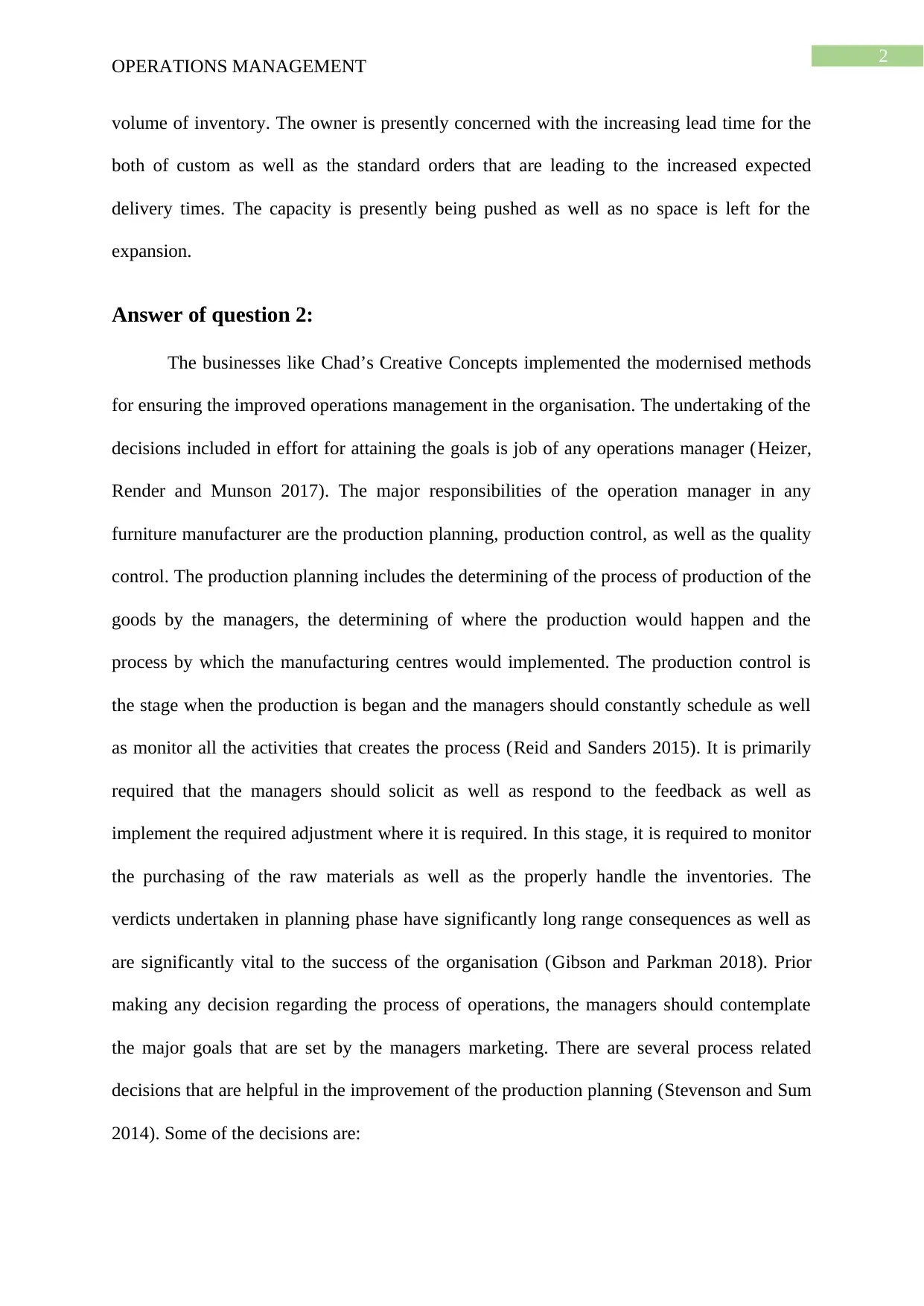
2
OPERATIONS MANAGEMENT
volume of inventory. The owner is presently concerned with the increasing lead time for the
both of custom as well as the standard orders that are leading to the increased expected
delivery times. The capacity is presently being pushed as well as no space is left for the
expansion.
Answer of question 2:
The businesses like Chad’s Creative Concepts implemented the modernised methods
for ensuring the improved operations management in the organisation. The undertaking of the
decisions included in effort for attaining the goals is job of any operations manager (Heizer,
Render and Munson 2017). The major responsibilities of the operation manager in any
furniture manufacturer are the production planning, production control, as well as the quality
control. The production planning includes the determining of the process of production of the
goods by the managers, the determining of where the production would happen and the
process by which the manufacturing centres would implemented. The production control is
the stage when the production is began and the managers should constantly schedule as well
as monitor all the activities that creates the process (Reid and Sanders 2015). It is primarily
required that the managers should solicit as well as respond to the feedback as well as
implement the required adjustment where it is required. In this stage, it is required to monitor
the purchasing of the raw materials as well as the properly handle the inventories. The
verdicts undertaken in planning phase have significantly long range consequences as well as
are significantly vital to the success of the organisation (Gibson and Parkman 2018). Prior
making any decision regarding the process of operations, the managers should contemplate
the major goals that are set by the managers marketing. There are several process related
decisions that are helpful in the improvement of the production planning (Stevenson and Sum
2014). Some of the decisions are:
OPERATIONS MANAGEMENT
volume of inventory. The owner is presently concerned with the increasing lead time for the
both of custom as well as the standard orders that are leading to the increased expected
delivery times. The capacity is presently being pushed as well as no space is left for the
expansion.
Answer of question 2:
The businesses like Chad’s Creative Concepts implemented the modernised methods
for ensuring the improved operations management in the organisation. The undertaking of the
decisions included in effort for attaining the goals is job of any operations manager (Heizer,
Render and Munson 2017). The major responsibilities of the operation manager in any
furniture manufacturer are the production planning, production control, as well as the quality
control. The production planning includes the determining of the process of production of the
goods by the managers, the determining of where the production would happen and the
process by which the manufacturing centres would implemented. The production control is
the stage when the production is began and the managers should constantly schedule as well
as monitor all the activities that creates the process (Reid and Sanders 2015). It is primarily
required that the managers should solicit as well as respond to the feedback as well as
implement the required adjustment where it is required. In this stage, it is required to monitor
the purchasing of the raw materials as well as the properly handle the inventories. The
verdicts undertaken in planning phase have significantly long range consequences as well as
are significantly vital to the success of the organisation (Gibson and Parkman 2018). Prior
making any decision regarding the process of operations, the managers should contemplate
the major goals that are set by the managers marketing. There are several process related
decisions that are helpful in the improvement of the production planning (Stevenson and Sum
2014). Some of the decisions are:
⊘ This is a preview!⊘
Do you want full access?
Subscribe today to unlock all pages.

Trusted by 1+ million students worldwide
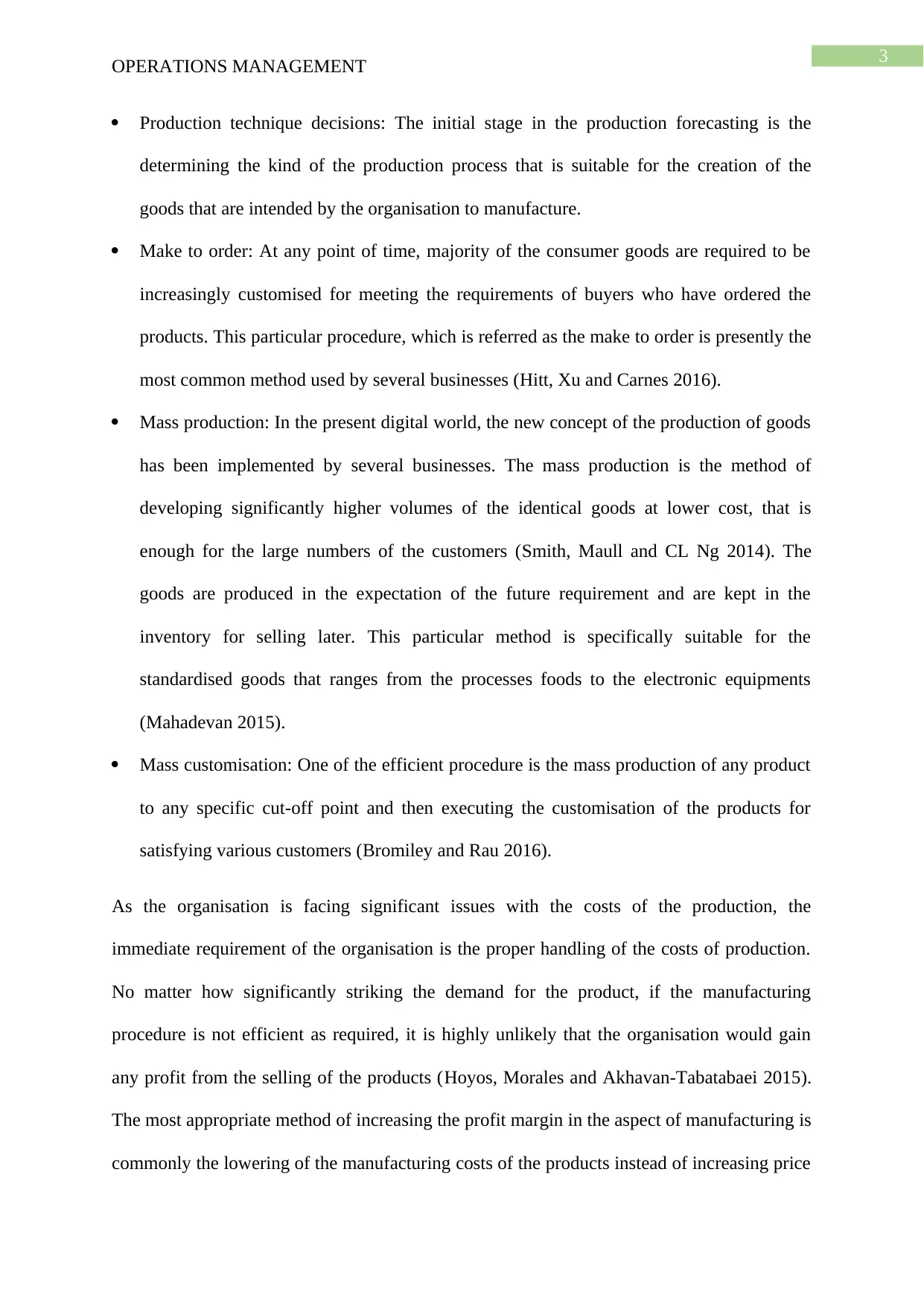
3
OPERATIONS MANAGEMENT
Production technique decisions: The initial stage in the production forecasting is the
determining the kind of the production process that is suitable for the creation of the
goods that are intended by the organisation to manufacture.
Make to order: At any point of time, majority of the consumer goods are required to be
increasingly customised for meeting the requirements of buyers who have ordered the
products. This particular procedure, which is referred as the make to order is presently the
most common method used by several businesses (Hitt, Xu and Carnes 2016).
Mass production: In the present digital world, the new concept of the production of goods
has been implemented by several businesses. The mass production is the method of
developing significantly higher volumes of the identical goods at lower cost, that is
enough for the large numbers of the customers (Smith, Maull and CL Ng 2014). The
goods are produced in the expectation of the future requirement and are kept in the
inventory for selling later. This particular method is specifically suitable for the
standardised goods that ranges from the processes foods to the electronic equipments
(Mahadevan 2015).
Mass customisation: One of the efficient procedure is the mass production of any product
to any specific cut-off point and then executing the customisation of the products for
satisfying various customers (Bromiley and Rau 2016).
As the organisation is facing significant issues with the costs of the production, the
immediate requirement of the organisation is the proper handling of the costs of production.
No matter how significantly striking the demand for the product, if the manufacturing
procedure is not efficient as required, it is highly unlikely that the organisation would gain
any profit from the selling of the products (Hoyos, Morales and Akhavan-Tabatabaei 2015).
The most appropriate method of increasing the profit margin in the aspect of manufacturing is
commonly the lowering of the manufacturing costs of the products instead of increasing price
OPERATIONS MANAGEMENT
Production technique decisions: The initial stage in the production forecasting is the
determining the kind of the production process that is suitable for the creation of the
goods that are intended by the organisation to manufacture.
Make to order: At any point of time, majority of the consumer goods are required to be
increasingly customised for meeting the requirements of buyers who have ordered the
products. This particular procedure, which is referred as the make to order is presently the
most common method used by several businesses (Hitt, Xu and Carnes 2016).
Mass production: In the present digital world, the new concept of the production of goods
has been implemented by several businesses. The mass production is the method of
developing significantly higher volumes of the identical goods at lower cost, that is
enough for the large numbers of the customers (Smith, Maull and CL Ng 2014). The
goods are produced in the expectation of the future requirement and are kept in the
inventory for selling later. This particular method is specifically suitable for the
standardised goods that ranges from the processes foods to the electronic equipments
(Mahadevan 2015).
Mass customisation: One of the efficient procedure is the mass production of any product
to any specific cut-off point and then executing the customisation of the products for
satisfying various customers (Bromiley and Rau 2016).
As the organisation is facing significant issues with the costs of the production, the
immediate requirement of the organisation is the proper handling of the costs of production.
No matter how significantly striking the demand for the product, if the manufacturing
procedure is not efficient as required, it is highly unlikely that the organisation would gain
any profit from the selling of the products (Hoyos, Morales and Akhavan-Tabatabaei 2015).
The most appropriate method of increasing the profit margin in the aspect of manufacturing is
commonly the lowering of the manufacturing costs of the products instead of increasing price
Paraphrase This Document
Need a fresh take? Get an instant paraphrase of this document with our AI Paraphraser

4
OPERATIONS MANAGEMENT
of any of the product. There are several methods that are presently implemented by the
companies working in the manufacturing industries (Choi, Cheng and Zhao 2016). Some of
the common methods are:
Reduction of labour costs: Within several situations, the immense expense that is
sustained by any manufacturing firm is within salaries that are paid to the factory workers. It
denotes that the reduction of the labour costs is the essential measure for cost cutting (Starr
and Van Wassenhove 2014). The money that is paid to the workers could be easily reduced
by the hiring of unskilled labour at significantly lower hourly rate than the presently pay
skilled workers (Ivanov, Tsipoulanidis and Schönberger 2017). Moreover, the replacement of
the skilled workers with the unskilled labour significantly diminishes the efficiency using
which work could be executed by the labour and it frequently increased the number of the
people that is required for hiring and the number of the stages that are included in the
production of the product prior it is completed.
Reduction of the cost of the materials: The raw materials that are required for the
production of the products is the significant section of the costs of production that are
included in the manufacturing (Matta et al. 2014). When significant amount of the
manufacturing expense is due to the costs of the raw materials, it makes immense sense to
search for new methods for reducing the expense. The company could buy the materials in
bulk amount for taking the benefit of the concessions on the bulk purchases from the
suppliers. Other method that could be implemented is the efficient negotiation with several
suppliers and then executing the comparison of the suppliers and search for the most
appropriate supplier who could provide the products at lowest rate.
Utilisation of lean manufacturing: The efficient utilisation of lean manufacturing is
presently the most effective method of keeping the costs of the production at lower rate. The
OPERATIONS MANAGEMENT
of any of the product. There are several methods that are presently implemented by the
companies working in the manufacturing industries (Choi, Cheng and Zhao 2016). Some of
the common methods are:
Reduction of labour costs: Within several situations, the immense expense that is
sustained by any manufacturing firm is within salaries that are paid to the factory workers. It
denotes that the reduction of the labour costs is the essential measure for cost cutting (Starr
and Van Wassenhove 2014). The money that is paid to the workers could be easily reduced
by the hiring of unskilled labour at significantly lower hourly rate than the presently pay
skilled workers (Ivanov, Tsipoulanidis and Schönberger 2017). Moreover, the replacement of
the skilled workers with the unskilled labour significantly diminishes the efficiency using
which work could be executed by the labour and it frequently increased the number of the
people that is required for hiring and the number of the stages that are included in the
production of the product prior it is completed.
Reduction of the cost of the materials: The raw materials that are required for the
production of the products is the significant section of the costs of production that are
included in the manufacturing (Matta et al. 2014). When significant amount of the
manufacturing expense is due to the costs of the raw materials, it makes immense sense to
search for new methods for reducing the expense. The company could buy the materials in
bulk amount for taking the benefit of the concessions on the bulk purchases from the
suppliers. Other method that could be implemented is the efficient negotiation with several
suppliers and then executing the comparison of the suppliers and search for the most
appropriate supplier who could provide the products at lowest rate.
Utilisation of lean manufacturing: The efficient utilisation of lean manufacturing is
presently the most effective method of keeping the costs of the production at lower rate. The
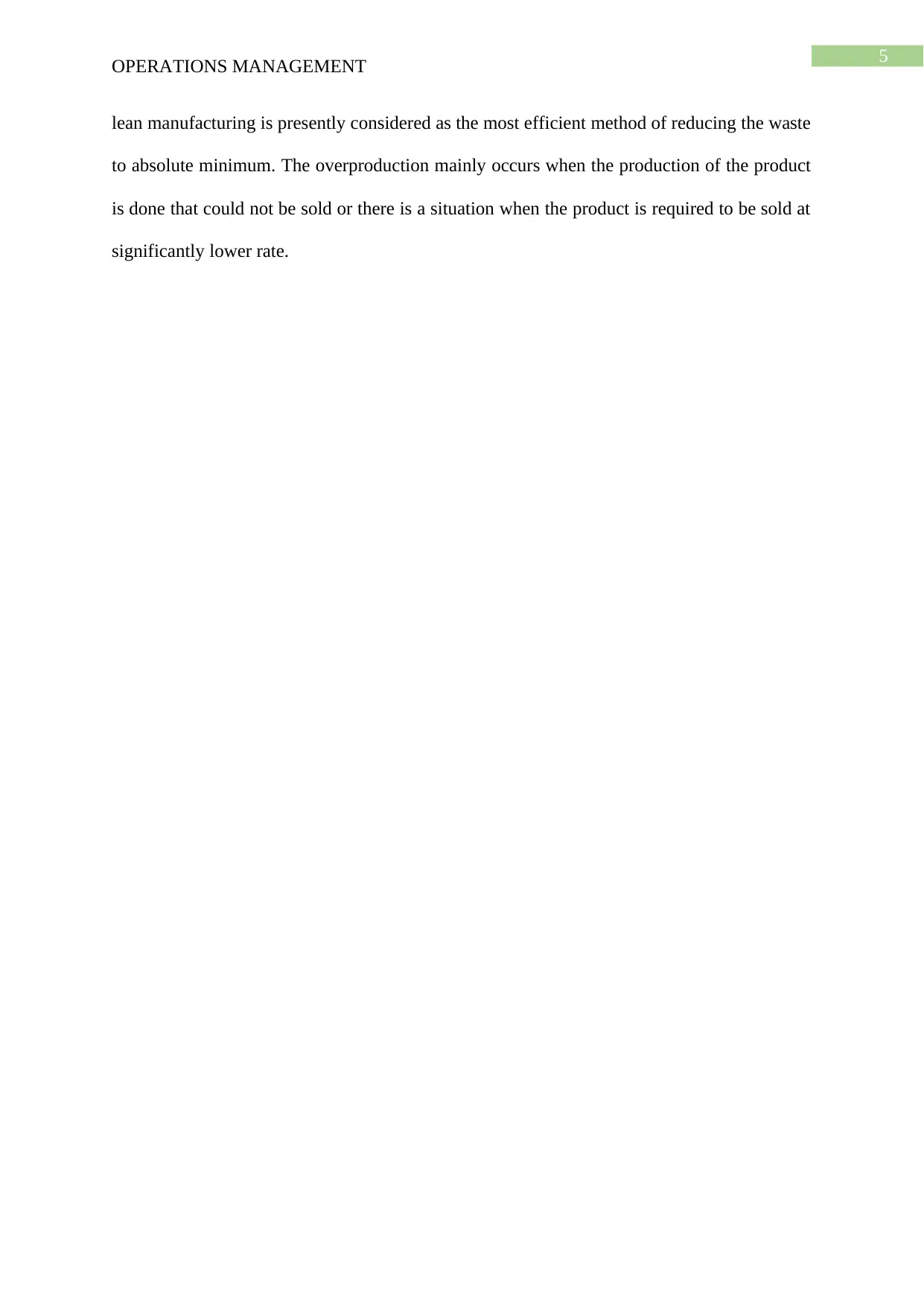
5
OPERATIONS MANAGEMENT
lean manufacturing is presently considered as the most efficient method of reducing the waste
to absolute minimum. The overproduction mainly occurs when the production of the product
is done that could not be sold or there is a situation when the product is required to be sold at
significantly lower rate.
OPERATIONS MANAGEMENT
lean manufacturing is presently considered as the most efficient method of reducing the waste
to absolute minimum. The overproduction mainly occurs when the production of the product
is done that could not be sold or there is a situation when the product is required to be sold at
significantly lower rate.
⊘ This is a preview!⊘
Do you want full access?
Subscribe today to unlock all pages.

Trusted by 1+ million students worldwide
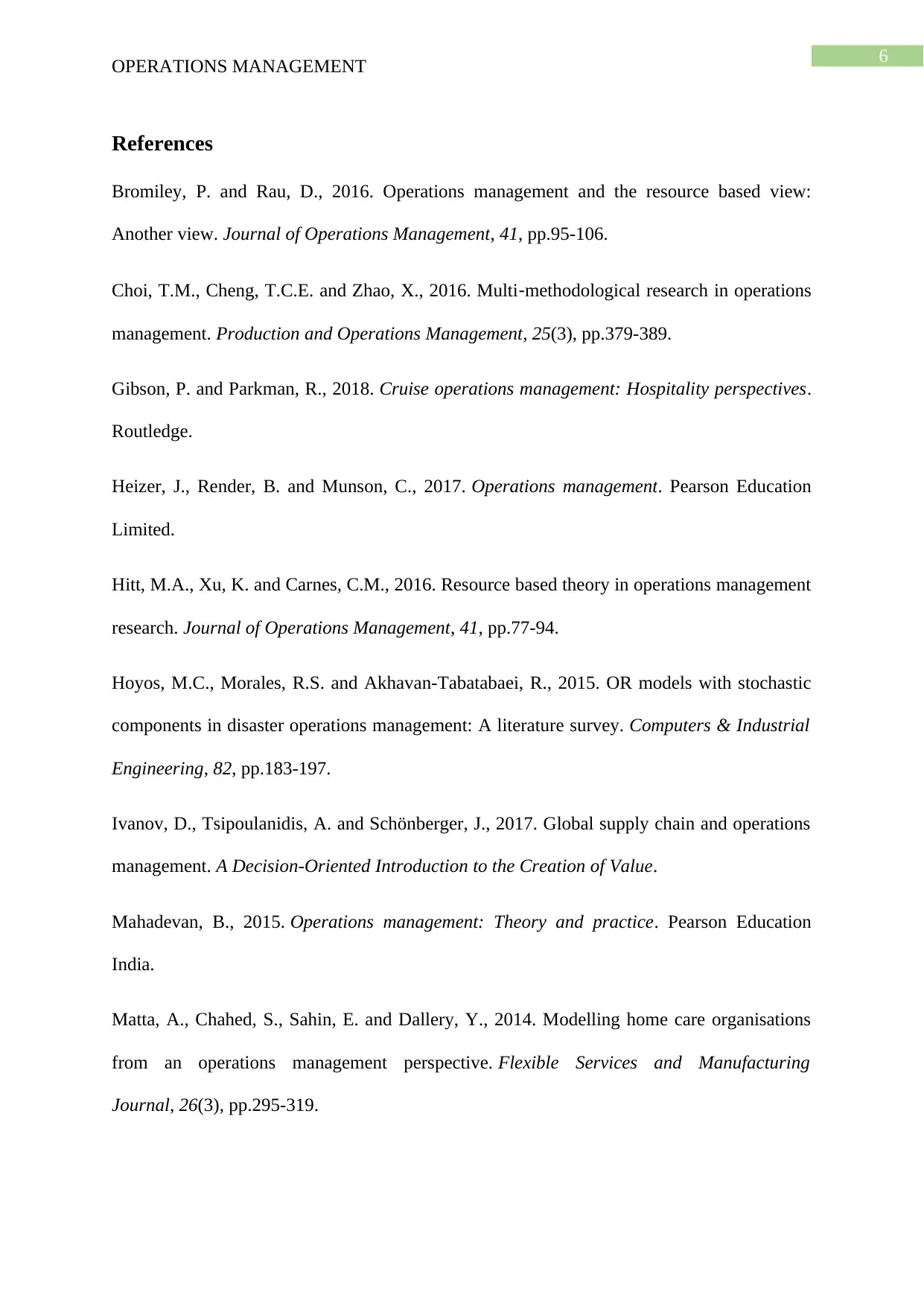
6
OPERATIONS MANAGEMENT
References
Bromiley, P. and Rau, D., 2016. Operations management and the resource based view:
Another view. Journal of Operations Management, 41, pp.95-106.
Choi, T.M., Cheng, T.C.E. and Zhao, X., 2016. Multi‐methodological research in operations
management. Production and Operations Management, 25(3), pp.379-389.
Gibson, P. and Parkman, R., 2018. Cruise operations management: Hospitality perspectives.
Routledge.
Heizer, J., Render, B. and Munson, C., 2017. Operations management. Pearson Education
Limited.
Hitt, M.A., Xu, K. and Carnes, C.M., 2016. Resource based theory in operations management
research. Journal of Operations Management, 41, pp.77-94.
Hoyos, M.C., Morales, R.S. and Akhavan-Tabatabaei, R., 2015. OR models with stochastic
components in disaster operations management: A literature survey. Computers & Industrial
Engineering, 82, pp.183-197.
Ivanov, D., Tsipoulanidis, A. and Schönberger, J., 2017. Global supply chain and operations
management. A Decision-Oriented Introduction to the Creation of Value.
Mahadevan, B., 2015. Operations management: Theory and practice. Pearson Education
India.
Matta, A., Chahed, S., Sahin, E. and Dallery, Y., 2014. Modelling home care organisations
from an operations management perspective. Flexible Services and Manufacturing
Journal, 26(3), pp.295-319.
OPERATIONS MANAGEMENT
References
Bromiley, P. and Rau, D., 2016. Operations management and the resource based view:
Another view. Journal of Operations Management, 41, pp.95-106.
Choi, T.M., Cheng, T.C.E. and Zhao, X., 2016. Multi‐methodological research in operations
management. Production and Operations Management, 25(3), pp.379-389.
Gibson, P. and Parkman, R., 2018. Cruise operations management: Hospitality perspectives.
Routledge.
Heizer, J., Render, B. and Munson, C., 2017. Operations management. Pearson Education
Limited.
Hitt, M.A., Xu, K. and Carnes, C.M., 2016. Resource based theory in operations management
research. Journal of Operations Management, 41, pp.77-94.
Hoyos, M.C., Morales, R.S. and Akhavan-Tabatabaei, R., 2015. OR models with stochastic
components in disaster operations management: A literature survey. Computers & Industrial
Engineering, 82, pp.183-197.
Ivanov, D., Tsipoulanidis, A. and Schönberger, J., 2017. Global supply chain and operations
management. A Decision-Oriented Introduction to the Creation of Value.
Mahadevan, B., 2015. Operations management: Theory and practice. Pearson Education
India.
Matta, A., Chahed, S., Sahin, E. and Dallery, Y., 2014. Modelling home care organisations
from an operations management perspective. Flexible Services and Manufacturing
Journal, 26(3), pp.295-319.
Paraphrase This Document
Need a fresh take? Get an instant paraphrase of this document with our AI Paraphraser
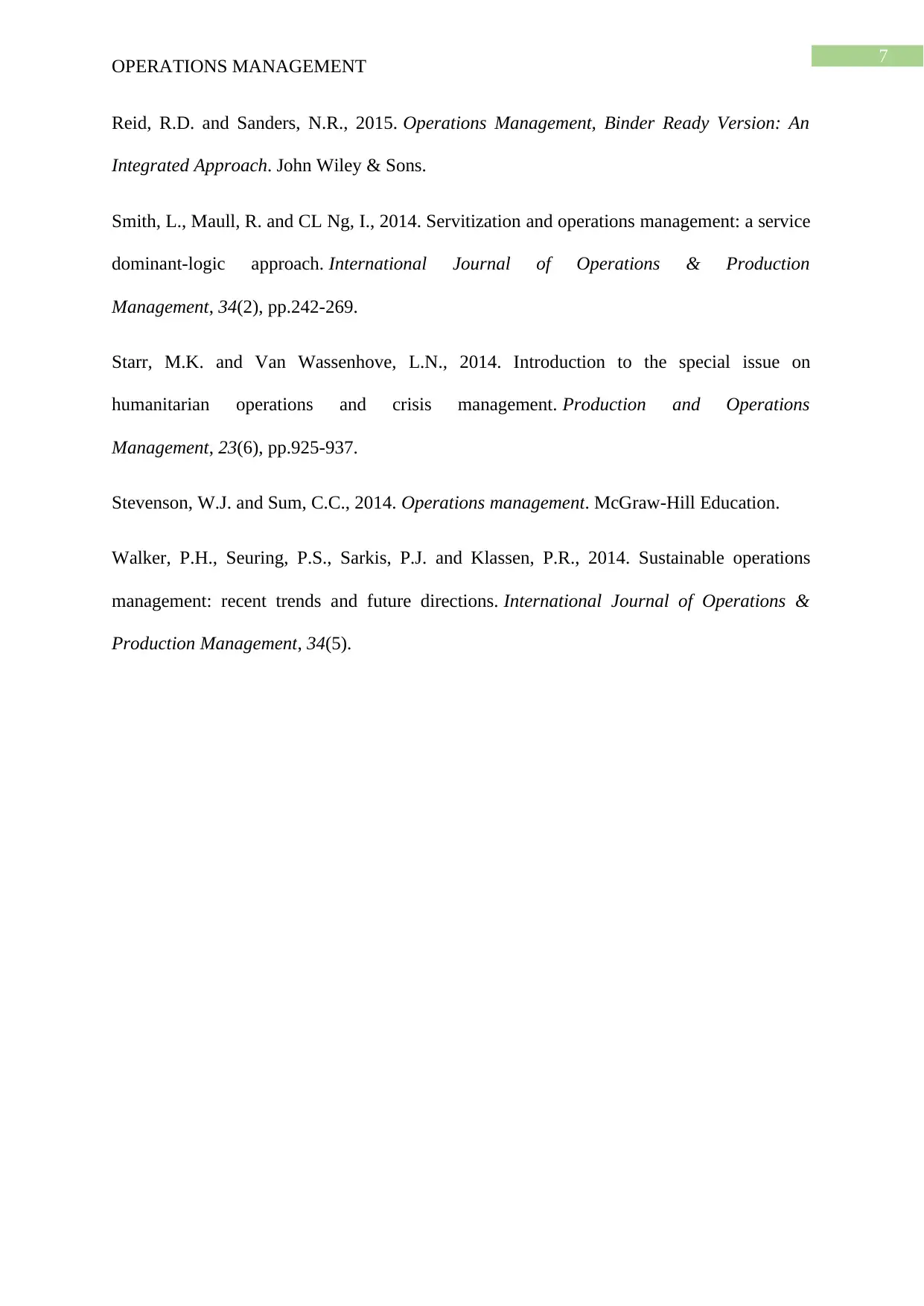
7
OPERATIONS MANAGEMENT
Reid, R.D. and Sanders, N.R., 2015. Operations Management, Binder Ready Version: An
Integrated Approach. John Wiley & Sons.
Smith, L., Maull, R. and CL Ng, I., 2014. Servitization and operations management: a service
dominant-logic approach. International Journal of Operations & Production
Management, 34(2), pp.242-269.
Starr, M.K. and Van Wassenhove, L.N., 2014. Introduction to the special issue on
humanitarian operations and crisis management. Production and Operations
Management, 23(6), pp.925-937.
Stevenson, W.J. and Sum, C.C., 2014. Operations management. McGraw-Hill Education.
Walker, P.H., Seuring, P.S., Sarkis, P.J. and Klassen, P.R., 2014. Sustainable operations
management: recent trends and future directions. International Journal of Operations &
Production Management, 34(5).
OPERATIONS MANAGEMENT
Reid, R.D. and Sanders, N.R., 2015. Operations Management, Binder Ready Version: An
Integrated Approach. John Wiley & Sons.
Smith, L., Maull, R. and CL Ng, I., 2014. Servitization and operations management: a service
dominant-logic approach. International Journal of Operations & Production
Management, 34(2), pp.242-269.
Starr, M.K. and Van Wassenhove, L.N., 2014. Introduction to the special issue on
humanitarian operations and crisis management. Production and Operations
Management, 23(6), pp.925-937.
Stevenson, W.J. and Sum, C.C., 2014. Operations management. McGraw-Hill Education.
Walker, P.H., Seuring, P.S., Sarkis, P.J. and Klassen, P.R., 2014. Sustainable operations
management: recent trends and future directions. International Journal of Operations &
Production Management, 34(5).
1 out of 8
Related Documents
Your All-in-One AI-Powered Toolkit for Academic Success.
+13062052269
info@desklib.com
Available 24*7 on WhatsApp / Email
![[object Object]](/_next/static/media/star-bottom.7253800d.svg)
Unlock your academic potential
Copyright © 2020–2025 A2Z Services. All Rights Reserved. Developed and managed by ZUCOL.




